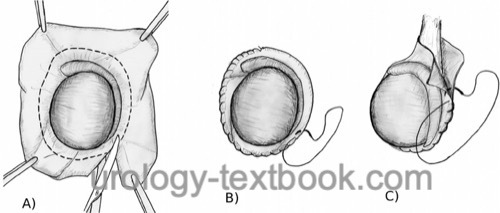You are here: Urology Textbook > Surgery (procedures) > Hydrocele operations
Hydrocelectomy: Surgical Technique and Complications
Indications for Hydrocelectomy
Large size or pain due to a hydrocele is an indication of hydrocelectomy; see also section hydroceles.
. |
.
 |
Contraindications
Coagulation disorders, local skin infections, significant comorbidity with an increased risk for surgery. Hydroceles caused by severe hepatic or cardiac insufficiency should not be treated surgically.
Surgical Techniques of Hydrocele Operations
Preoperative Patient Preparation
- Patient positioning: supine position
- General, spinal, or local anesthesia
- Perioperative antibiotic prophylaxis
Surgical Approach for Hydrocelectomy:
An inguinal approach is necessary for open processus vaginalis, hydrocele of the spermatic cord, or if a testicular tumor is suspected. A scrotal approach is used for hydrocele testis.
Hydrocelectomy with Excision of the Hydrocele Sac:
Incise the hydrocele sac after complete mobilization of the hydrocele. Partially resect the hydrocele sac, leaving a 1–2 cm margin. Do not injure the testicular vessels, epididymis, or ductus deferens. Oversew the edges of the hydrocele sac for hemostasis (von Bergmann technique), or the edges are everted and sewn together behind the testis (Winkelmann or Jaboulay technique). Consider a closed suction drain after extensive dissection or bleeding diasthesis. Hydrocele surgery with excision of the hydrocele sac is useful for large or thick-walled hydroceles and multilocular hydroceles; see also the following figures:
| Do you want to see the illustration? Please support this website with a Steady membership. In return, you will get access to all images and eliminate the advertisements. Please note: some medical illustrations in urology can be disturbing, shocking, or disgusting for non-specialists. Click here for more information. |
| Do you want to see the illustration? Please support this website with a Steady membership. In return, you will get access to all images and eliminate the advertisements. Please note: some medical illustrations in urology can be disturbing, shocking, or disgusting for non-specialists. Click here for more information. |
| Do you want to see the illustration? Please support this website with a Steady membership. In return, you will get access to all images and eliminate the advertisements. Please note: some medical illustrations in urology can be disturbing, shocking, or disgusting for non-specialists. Click here for more information. |
| Do you want to see the illustration? Please support this website with a Steady membership. In return, you will get access to all images and eliminate the advertisements. Please note: some medical illustrations in urology can be disturbing, shocking, or disgusting for non-specialists. Click here for more information. |
| Do you want to see the illustration? Please support this website with a Steady membership. In return, you will get access to all images and eliminate the advertisements. Please note: some medical illustrations in urology can be disturbing, shocking, or disgusting for non-specialists. Click here for more information. |
| Do you want to see the illustration? Please support this website with a Steady membership. In return, you will get access to all images and eliminate the advertisements. Please note: some medical illustrations in urology can be disturbing, shocking, or disgusting for non-specialists. Click here for more information. |
| Do you want to see the illustration? Please support this website with a Steady membership. In return, you will get access to all images and eliminate the advertisements. Please note: some medical illustrations in urology can be disturbing, shocking, or disgusting for non-specialists. Click here for more information. |
| Do you want to see the illustration? Please support this website with a Steady membership. In return, you will get access to all images and eliminate the advertisements. Please note: some medical illustrations in urology can be disturbing, shocking, or disgusting for non-specialists. Click here for more information. |
Hydrocele Surgery with Plication of the Hydrocele Sac:
The hydrocele is opened with a small skin incision without further dissection. The hydrocele sac is reduced (plicated) by suture Hydrocele surgery: Lord technique. The plication technique is suitable for medium-sized and thin-walled hydroceles. The advantage of the plication technique is the minimized dissection with a reduced complication rate (Tsai et al., 2019).
Postoperative Care
Pain medication, pressure dressing (and drain) for 1–2 days, avoid physical activity, bed rest and elevate scrotum, regular wound examination.
Complications of Hydrocelectomy
- Bleeding and hematoma (up to 10%)
- Infection (3-5%)
- Recurrence of hydrocele below 5%
- Obstruction of the epididymal duct with infertility
- Chronic pain
- Testicular atrophy due to vascular injury is rare.
| Retroperitoneal lymphadenectomy | Index | Spermatocelectomy |
Index: 1–9 A B C D E F G H I J K L M N O P Q R S T U V W X Y Z
References
Ku u.a. 2001 KU, J. H. ; KIM, M. E. ;
LEE, N. K. ; PARK, Y. H.:
The excisional, plication and internal drainage techniques: a
comparison of the results for idiopathic hydrocele.
In: BJU Int
87 (2001), Nr. 1, S. 82–4
J. A. Smith, S. S. Howards, G. M. Preminger, and R. R. Dmochowski, Hinman’s Atlas of Urologic Surgery Revised Reprint. Elsevier, 2019.
Swartz MA, Morgan TM, Krieger JN. Complications of scrotal surgery for benign conditions. Urology. 2007 Apr;69(4):616-9. doi: 10.1016/j.urology.2007.01.004.
L. Tsai, P. A. Milburn, C. L. Cecil, P. S. Lowry, and M. R. Hermans, “Comparison of Recurrence and Postoperative Complications Between 3 Different Techniques for Surgical Repair of Idiopathic Hydrocele.,” Urology, vol. 125, pp. 239–242, 2019.
 Deutsche Version: Operationen der Hydrozele
Deutsche Version: Operationen der Hydrozele